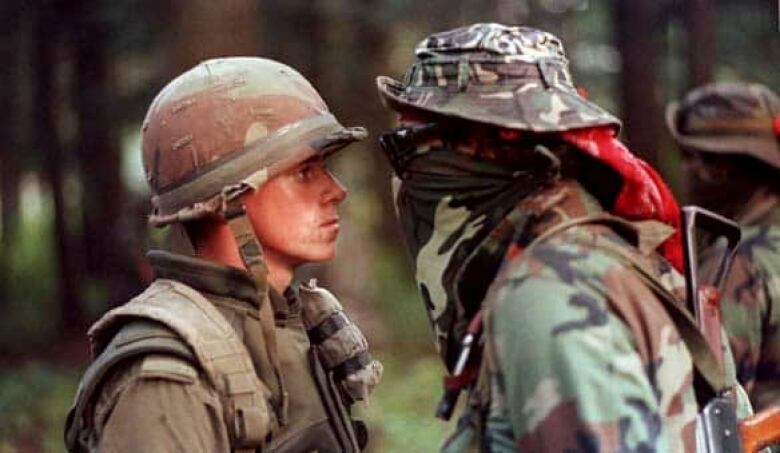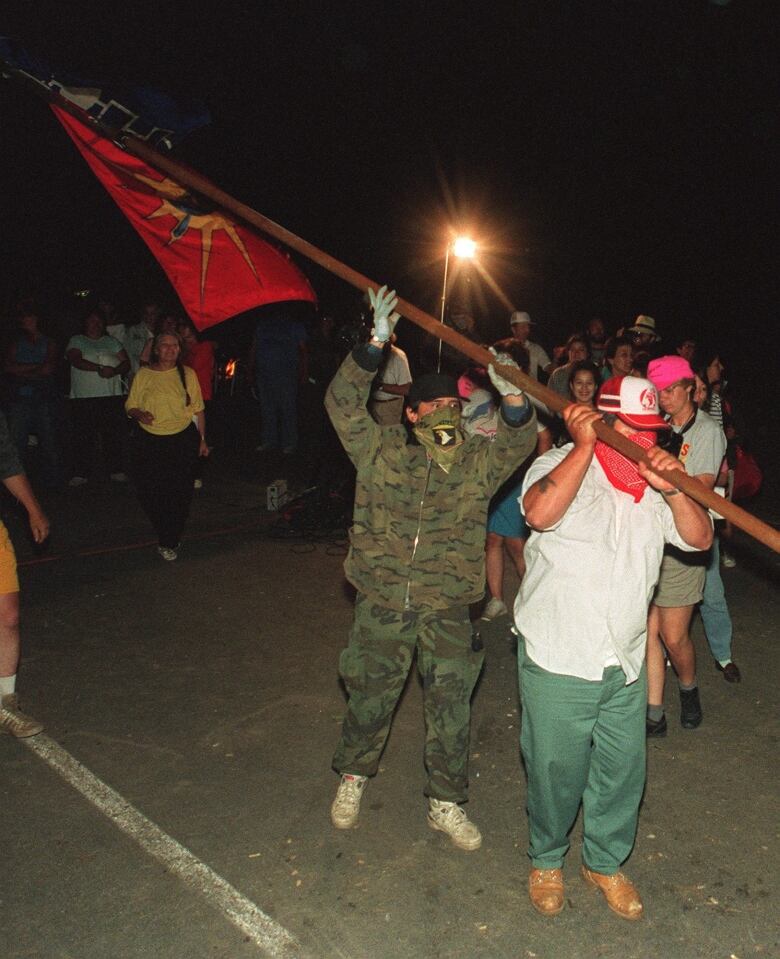Oka Crisis legacy questioned
Sunday marks 20th anniversary of start of 78-day standoff

Twenty years after the Oka Crisis there are differing views over whether the relationship between the government and First Nationshas improved.
Sunday marks two decades since the start of the 78-day-long standoff between Mohawks in the community of Kanesatake andpolice and the military.
The conflict in the community west of Montreal was sparked by plans to expand a golf course in the neighbouring community of Oka on land the Mohawk claimed was a traditional burial ground. A provincial police officer, Cpl. Marcel Lemay, was killed in gunfire during the early days of the crisis.

An agreement signed in Quebec City on Tuesday is an example of how relations have improved since 1990, said Federal Indian Affairs Minister Chuck Strahl. The agreement between the federal and provincial governments and the Assembly of First Nations in Quebecallows First Nations communities more power over the distribution of social assistance money, he said.
Although there are still more than 3,000aboriginal land claims outstanding including the one launched by the Mohawk of Kanesatake Strahl said they are being dealt with in a better way.
In 2007, Prime Minister Stephen Harper announced a revamp of the federal land-claims process. The changes included $250 million a year for 10 years to help manage the backlog of claims, and the creation of an independent tribunal tomake final decisions ondisputes.
Twenty years ago, Strahl said, there was confrontation, not negotiation. "The federal government has been much quicker to recognize that claims exist," said Strahl. "[It] used to be [that]we were just in complete denial. We would just say 'No, we're not going to negotiate, we're not talking, there's nothing to talk about.'"
'The federal government has been much quicker to recognize that claims exist.' Indian Affairs Minister Chuck Strahl
But the Quebec chief of the Assembly of First Nations, Ghislain Picard, said he has his doubts. Picard points to the number of outstanding land claims and to the Royal Commission Report on Aboriginal Peoples, which was set up after the Oka Crisis.
In 1996, the commission made more than 400 recommendations, including a 20-year agenda to "revitalize" First Nations communities and end the "staggering" human and financial cost of supporting them.
'What has changed?'
"What has changed since Oka?" asked Picard. "How many of those recommendations have been implemented?"
Tensions have recently flaredagain in Kanesatake over a developer's plan to build three homes on a site across the street from the pine forest where the standoff began. Taxes on the land are paid to the municipality of Oka. But members of the Mohawk community argue that the land belongs to them, aspart of an ongoing claim.
Residents of Kanesatake have also sought a moratorium on a plan to extract and mill niobium in the region until the claim isresolved. Niobium is used in superconductors and in alloys such as high-strengthsteel forpipelines andbone implants.
The current grand chief of the Kanesatake Mohawk, Sohenrise Paul Nicholas, said there has been progress on the land claim, but at a snail's pace. "We are the point now where we are going to be starting discussion," said Nicholas.
That little has changed in two decades comes as no surprise to two key players in the Oka Crisis.
'We never learn from history'
"We never learn from history, do we?" John Ciaccia said with a sigh. The former Quebec native affairs minister was at the centre of the storm two decades ago. He was at odds with his own government and police, while scrambling to broker a deal and prevent further bloodshed.
'The whole crisis could have been avoided with common sense and respect for the native community.' Former Quebec native affairs minister John Ciaccia
In the months leading up to the crisis, Ciaccia pushed Ottawa to OK an agreement that would have let the disputed territory be acquired by the federal government and given over to the Kanesatake Mohawks.
Ciaccia's voice still chokes with anger and frustration as he recalls the events of that long summer.
Under police protection for much of the crisis, he was also branded a traitor by some of his then-colleagues. Ten years ago, he went public with his view that the blame for the crisis should be placed squarely on thegovernments of the time the Quebec Liberal administration ofRobert Bourassa and the federal Conservative government under Brian Mulroney.
"It was wrong to put the natives in that position," the retired politician maintains. "The whole crisis could have been avoided with common sense and respect for the native community."

Ottawa blamed
Even at the height of the crisis, he said, Ottawa refused to budge while he struggled to find common ground between the Mohawk leaders and the government. Ottawa dragged its heels,and continues to do so today, Ciaccia said.
It's an opinion echoed by Ellen Gabriel. In 1990, the then 31-year-old firebrand acted as chief Mohawk negotiator, working alongside Ciaccia to bring an end to the stalemate.
Nowpresident of a native women's association, she says Oka's only legacy is a greater awareness of native issues across Canada. "If anything it was a waking up," she said, adding that people realized "in a simplified, clichd way, there are still ongoing Indian wars."
The initial transfer of the Oka land took place in 1717, when France gave it over to a missionary group.
"It's a 290-year-old fight," said Gabriel. "So history's not changing. It's business as usual as far as the government is concerned."
Kanesatake residents planned an evening of songs and poetry on Saturday and a march Sunday from Oka to the site of the protest camp where the crisis began. The marchers were to bejoined bysome Oka villagers and local farmers who share the opposition tothe niobium mine.
All Quebecers have also been invited tothe annual Powwow in the Mohawk community of Kahnawake, south of Montreal.
Kahnawake's grand chief, Mike Delisle, and local Bloc Qubcois MP Carole Freemanbilled the event, running through the weekend,as an opportunity to heal scars that still remain following the crisis.
With files from The Canadian Press













_(720p).jpg)


 OFFICIAL HD MUSIC VIDEO.jpg)
.jpg)



























































































